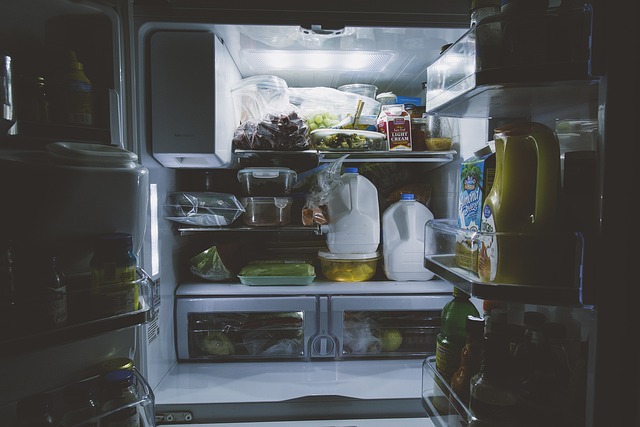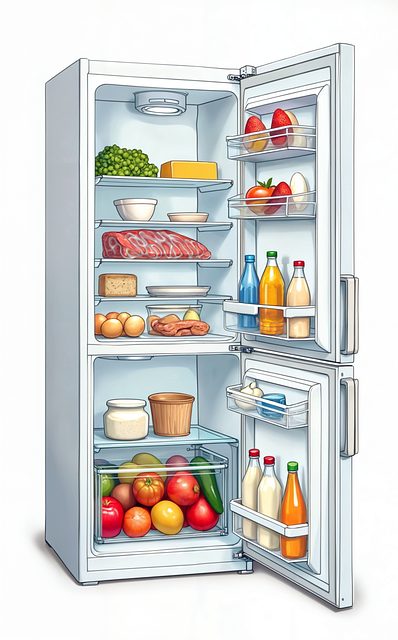Regularly maintaining your refrigerator's door seal is key to ensuring its energy efficiency and prolonging its lifespan. Over time, these seals can degrade, leading to air leaks and increased energy consumption as the fridge works harder to maintain temperature. A simple test to check for a proper seal is to insert a dollar bill between the door and frame; if it slides out easily after a day, the seal may need attention. Homeowners can repair or replace the door seal themselves by inspecting for damage, cleaning or replacing the rubber gasket as necessary, and ensuring it's securely installed without gaps. For those who prefer professional assistance, refrigerator repair services are available to handle door seal issues. Regular upkeep of this critical component not only saves on utility bills but also prevents excessive strain on your refrigerator's components, making it a smart and economical choice for homeowners looking to maintain an energy-efficient household.
Maintaining your refrigerator’s efficiency is key to conserving energy and reducing utility bills. A critical aspect of this appliance’s performance is its door seals, which play an indispensable role in preventing energy loss. This article delves into the significance of these seals and provides a comprehensive guide for their repair and replacement. By understanding how to effectively manage your refrigerator’s door seals through refrigerator repair techniques, you can ensure optimal appliance function and contribute to a more sustainable home environment.
- Understanding the Importance of Door Seals in Refrigerator Efficiency
- Step-by-Step Guide to Repairing and Replacing Door Seals on Your Refrigerator
Understanding the Importance of Door Seals in Refrigerator Efficiency

Regular refrigerator repair and maintenance, including door seal inspection and replacement when necessary, are crucial for maintaining energy efficiency and ensuring optimal performance. Door seals on a refrigerator serve as the first line of defense against air leaks and temperature loss. Over time, these seals can degrade due to factors like wear and tear, extreme temperatures, and exposure to various chemicals and contaminants. When door seals become compromised, they fail to create an effective seal, leading to energy loss that forces your refrigerator to work harder to maintain the desired temperature. This not only increases your electricity bills but also strains the refrigerator’s components, potentially leading to more costly repairs or even replacement down the line.
To ascertain whether your refrigerator’s door seals are functioning correctly, conduct a simple test: close the door on a dollar bill or a piece of paper and leave it there for a day. If you can easily remove the bill without resistance, this indicates a poor seal. Addressing this issue promptly through door seal repair or replacement is essential for preserving your refrigerator’s efficiency and longevity. It’s a straightforward task that can be performed by homeowners with basic DIY skills or by calling in a professional for refrigerator repair services. By regularly inspecting and maintaining your fridge’s door seals, you’re taking an important step towards minimizing energy consumption and ensuring that your appliance operates at peak performance, ultimately saving you money on utility bills.
Step-by-Step Guide to Repairing and Replacing Door Seals on Your Refrigerator

Maintaining an energy-efficient household often involves routine checks and maintenance, such as repairing or replacing door seals on your refrigerator. A compromised seal can lead to significant energy loss, causing your appliance to work harder and increasing your utility bills. To ensure your refrigerator operates at peak efficiency, follow this step-by-step guide for repairing or replacing its door seals.
Begin by visually inspecting the rubber gasket around your refrigerator’s door. Look for cracks, splits, or deterioration that could disrupt a proper seal. If you find minor damage that can be repaired, clean the gasket thoroughly with mild soap and water to remove any debris or buildup that may have contributed to wear. Use a flat head screwdriver to gently press down on the edges of the gasket to reform its shape if it’s slightly warped. For more extensive damage, you may need to replace the entire seal.
To replace the door seal, start by unscrewing any visible fasteners that hold the seal in place. Carefully remove the old seal, taking note of how it is aligned and secured. This will ensure a smooth installation of the new seal. Position the new seal, making sure it aligns with the door’s frame and fits snugly without obstruction. Reattach the fasteners, ensuring they are tight enough to hold the seal securely but not so tight that they damage the new gasket. After reinstallation, perform another visual inspection to confirm there are no gaps or irregularities in the seal. Properly maintained door seals can significantly reduce energy loss and contribute to a more energy-efficient home. Regularly checking and maintaining your refrigerator’s door seals is a simple yet effective way to save on energy costs and prolong the lifespan of your appliance.
Effective door seal maintenance is pivotal for optimizing your refrigerator’s efficiency, mitigating energy loss, and safeguarding your food’s freshness. This article has outlined the significance of door seals in maintaining a refrigerator’s performance and provided a comprehensive guide on repairing and replacing these seals. By following the steps detailed, you can ensure your refrigerator operates at its best, reducing the strain on its mechanism and lowering utility bills. Regularly inspecting and maintaining your refrigerator’s door seals is a simple yet effective way to contribute to energy conservation and appliance longevity—key aspects of responsible household management. Remember, when it comes to refrigerator repair, addressing seal issues promptly can make a substantial difference in overall efficiency.
